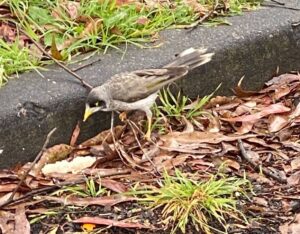Australia has some wonderful native birdlife and there are many ways to encourage our feathered friends into our gardens. Don recently asked bird expert Graham Pizzey for some clues on which native garden plants are attractive to birds.
By choosing your plants carefully you can often bring the birds into your garden and their sounds, songs and colour add life to many gardens, as well as bringing a little piece of nature to our own back door.
The plants you select depend on your climate says Graham Pizzey. According to Graham one of the best bird trees for Victoria is the red-flowered yellow gum (Eucalyptus leucoxylon).
Trees and shrubs in your garden not only provide food for the birds but also shelter for nesting, especially plants with prickly foliage.
Plant selection
Some other trees and shrubs which are attractive to birds include the following:
Eucalypts: These trees often have hollows in their trunk or in branch forks which provide shelter and nesting sites for many birds. Some eucalypts especially attractive to birds include: E. planchoniana – medium-sized tree to 25m which attracts birds with its cream-coloured flowers. E. pyriformis – small tree with large and heavy red or yellow flowers. Grows to 5m.
Banksias: Most banksias are found to be attractive to birdlife especially to honeyeaters. There are banksias that will grow in most parts of Australia. Some examples are: B. ‘Giant Candles’ – a cultivar with large orange flower spikes which can grow to 40cm in length. B. spinulosa – a smallish shrub to 1.5m with orange-yellow flowers. It is often laden with flowers in winter.
Grevilleas: Many species of grevilleas are highly attractive to birds because of the nectar produced by the flowers. Some of these include: Grevillea alpina – shrub to 2m which has flowers present for most of the year except autumn. Best in cooler zones, particularly southern Australia. G. asparagoides – prickly shrub to 1m which also makes a good screening plant. G. beardiana – a small shrub (to 60cm) with clusters of red flowers. G. ‘Boongala Spinebill’ – honeyeaters are very attracted to the red toothbrush-like flowers on this sprawling shrub.
G. ‘Honey Gem’ – a tall shrub with apricot flowers. Grows to 6m tall. Excellent plant to attract native, nectar feeding birds. G. ‘Ivanhoe’ – a dense shrub good for screening. Has attractive foliage and red flowers which feature for most of the year. G. robusta – the silky oak, a tall growing tree which flowers in spring with golden nectar-laden flowers. This tree is too large for a small to medium garden. G. shiressii (Mullet Creek grevillea) – shrub to 3m with blue-green flowers during winter and spring. Not widely available commercially.
Others
Some other plants which Graham mentioned as good bird attractors were: Black bean tree (Castanospermum australe) – best in a warm to hot climate such as the tropics and sub-tropics. Red and yellow flowers in mid to late spring. Dense canopy of dark green leaves. Wild cherry (Exocarpos cupressiformis) – there are many species of this parasitic plant through Australia.
Additional attractions
Other factors to consider for a bird-friendly garden are: availability of water for the birds – be aware of its location as birds will not use it if they feel threatened by predators. Situate the water near shrubs or trees to give some privacy and a feeling of protection for the birds. plant a variety of shrubs and trees for a varied diet for the birds. Native fruits are often sought after by birds and seeds may also play a part in their diet. Grasses provide seeds and are an interesting dam or pond addition. prickly shrubs provide good protection for birds so plant these near a water source and throughout the garden for safe nesting sites.
Further information
For more information about native plants or birdscaping your garden contact your local branch of the Society for Growing Australian Plants (SGAP). State contacts are given below (Northern Territory residents contact a neighbouring state). The ACT group has produced information on bird attracting plants (see details for ACT contact below).
The SGAP maintains a comprehensive website at: www.austplants-nsw.org.au/. Or use your search engine to search for “SGAP”. State branches also have websites.
ACT
Society for Growing Australian Plants – Canberra Region Inc
PO Box 217
Civic Square 2608
Phone: (02) 6251 1501
Website: nativeplants-canberra.asn.au
NSW
Society for Growing Australian Plants (Australian Plant Society)
PO Box 744
Blacktown 2148
Phone: (02) 9621 3437
Website: www.austplants-nsw.org.au
QLD
SGAP
48 Chermside Street
Wellington Point 4160
Phone: (07) 3207 1597
Website: www.sgapqld.org.au/qldregion.html
SA
The SGAP SA Region Inc
17 Grandview Drive
Tea Tree Gully 5091
Phone: (08) 8264 0270
Website: members.iweb.net.au/~sgap/
TAS
SGAP, Tasmanian Region Inc
176 Summerleas Road
Kingston 7050
Phone: (03) 6229 1710
VIC
SGAP Victoria
48 Montrose Road
Montrose 3765
Phone: (03) 9728 5891.
Website: home.vicnet.net.au/~sgapvic/
WA
Wildflower Society of WA (Inc)
71 Oceanic Drive
Floreat 6014
Phone: (08) 9383 7979
NT
Please contact a neighbouring state.
Further reading
A Garden of Birds. Attracting Birds to Australian Gardens by Graham Pizzey. Angus and Robertson. ISBN 0 207 16213 1.
Bird Attracting Plants by John W. Wrigley and Murray Fagg. Angus and Robertson. ISBN 0 207 16866 0.



